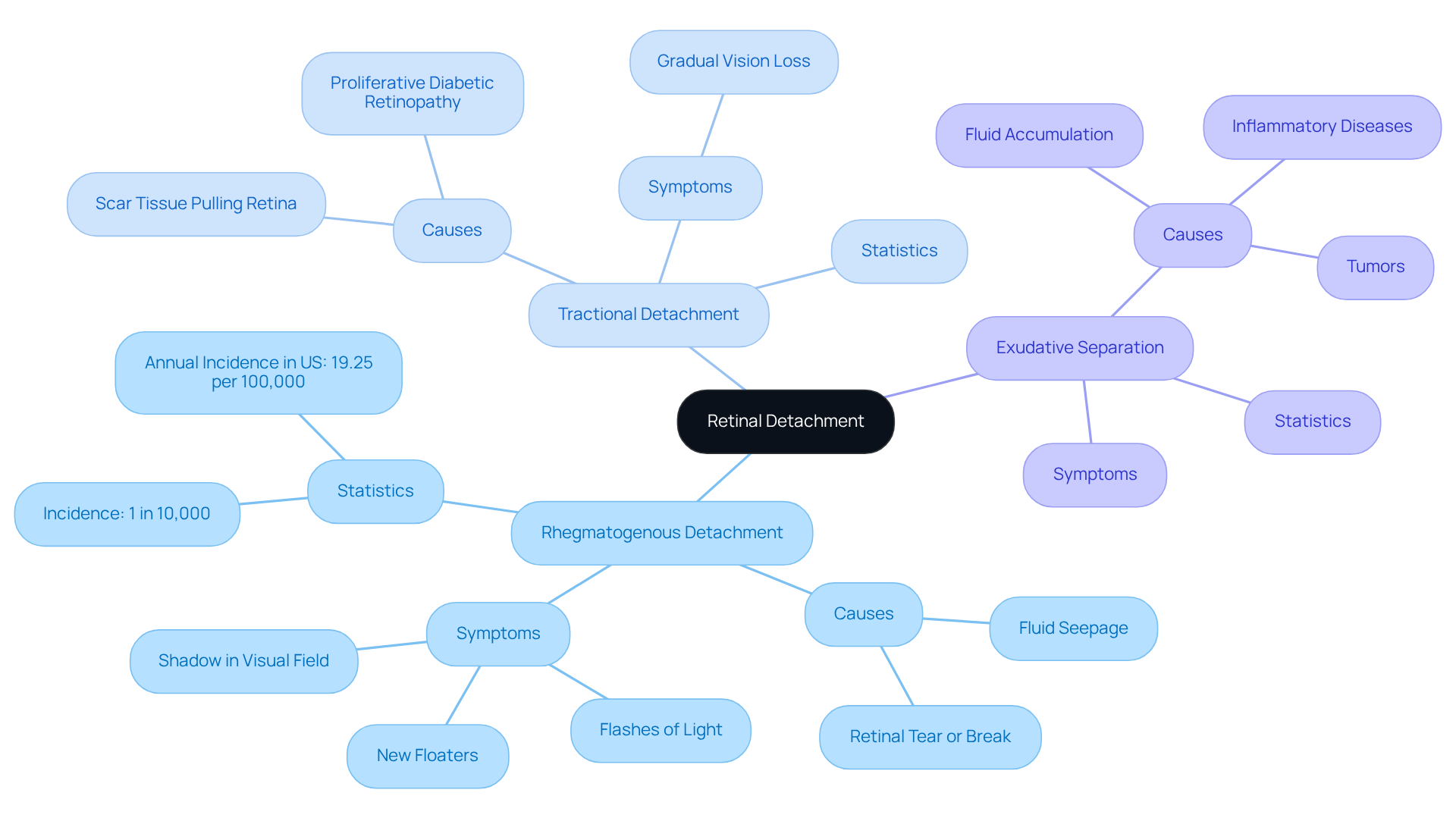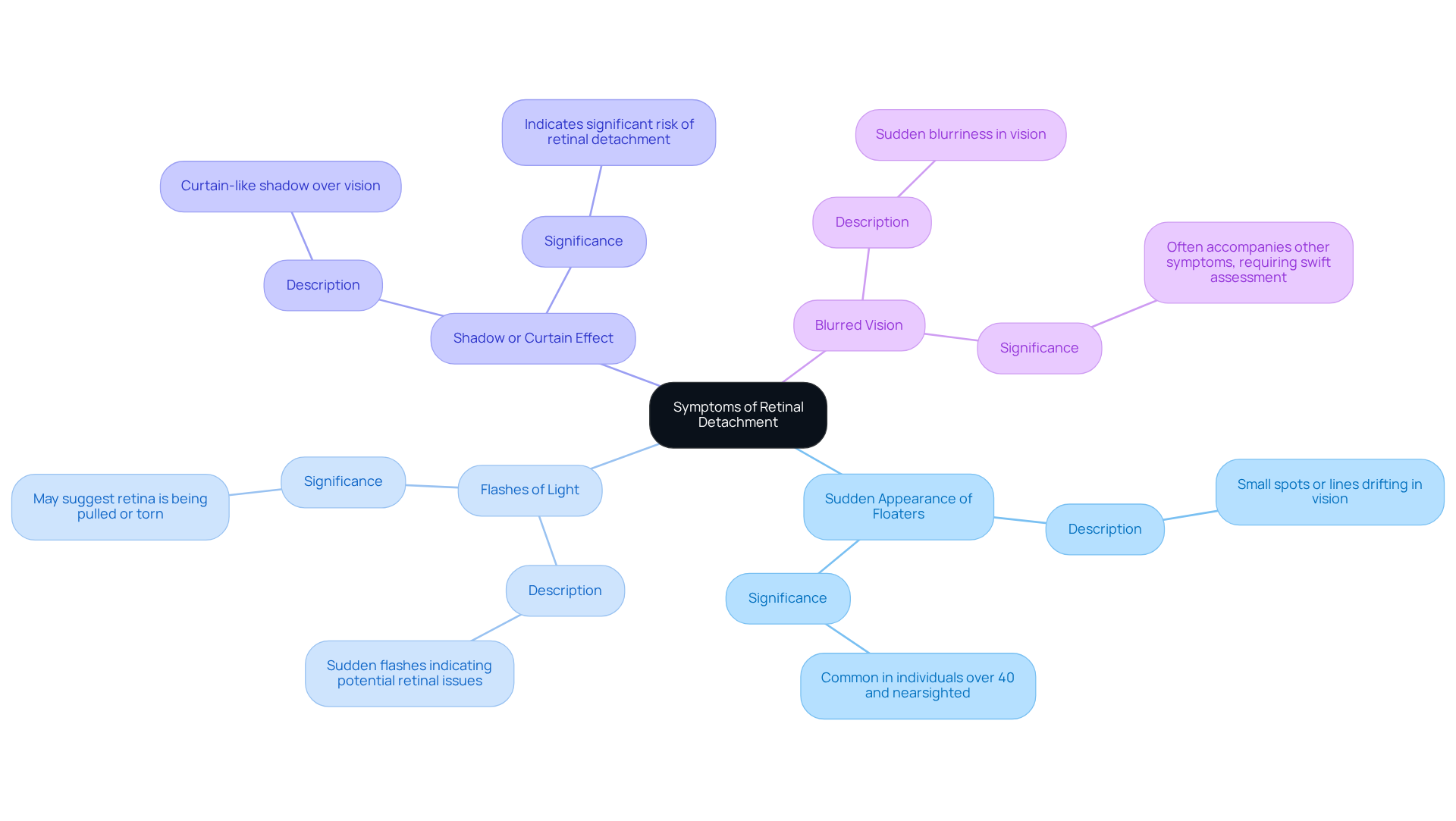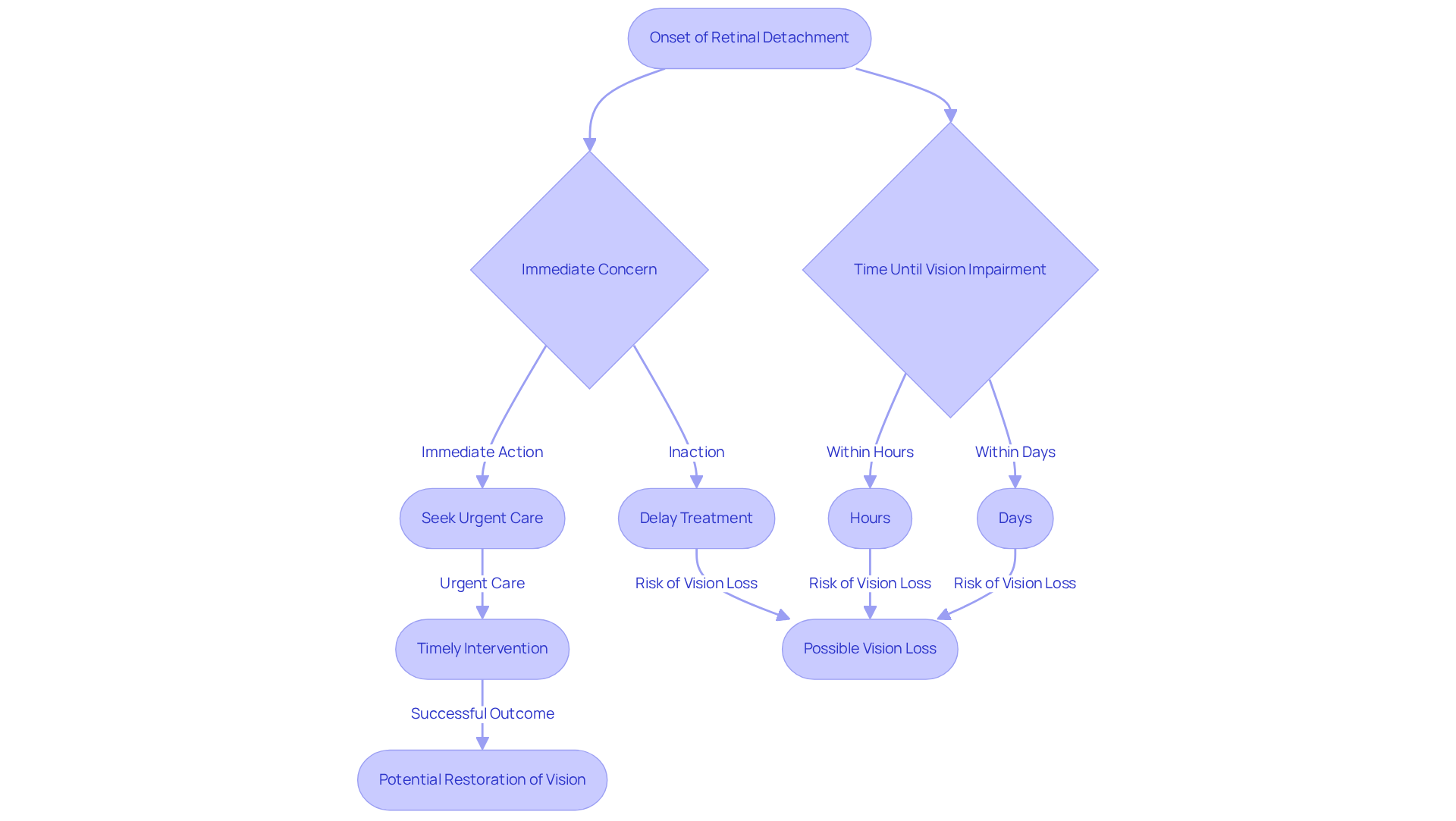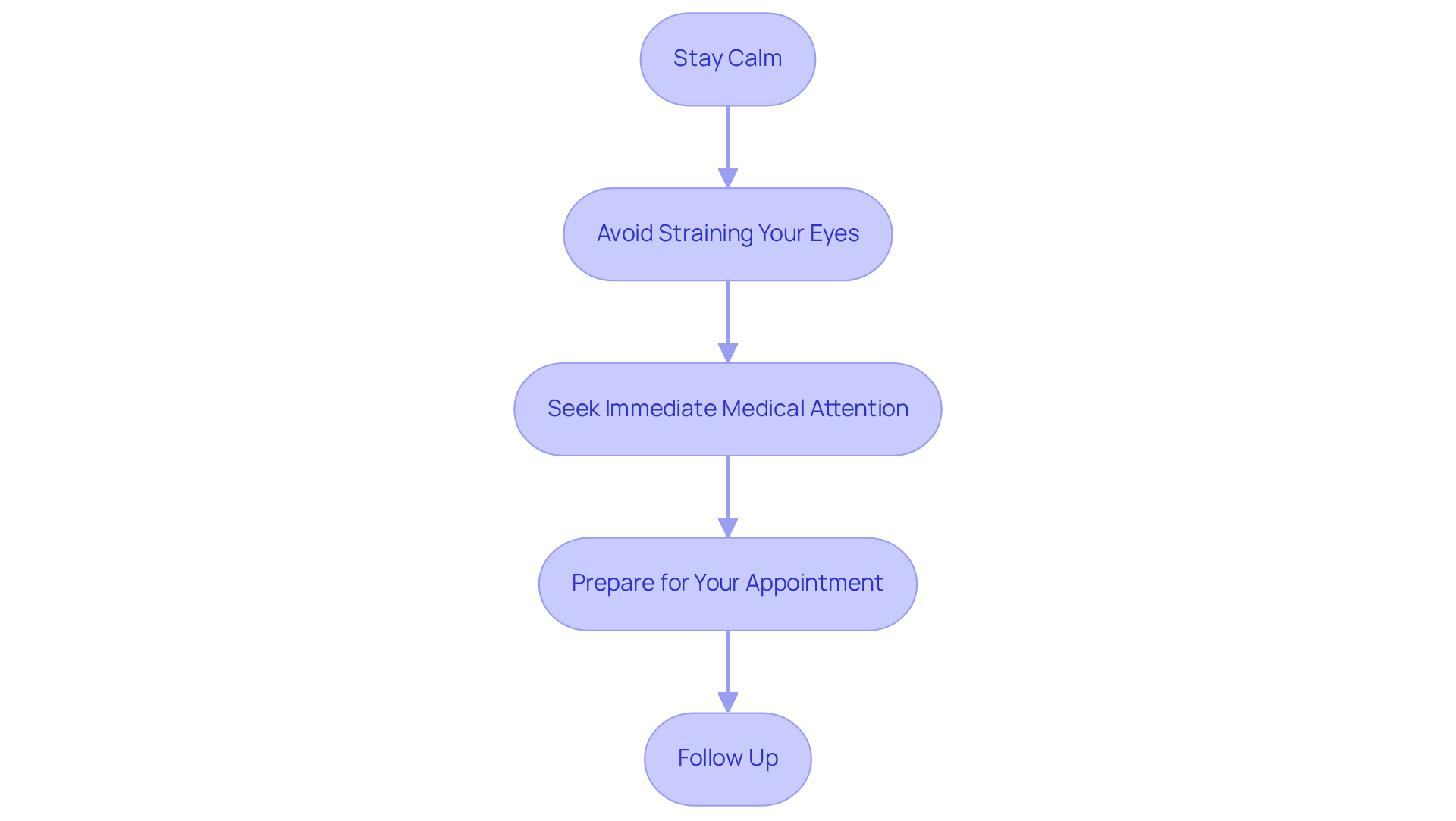Posted by: Northwest Eye in General on August 15, 2025
Overview
Retinal detachment is a serious condition that can lead to blindness within just 24 to 72 hours if not treated promptly. We understand that this can be a frightening prospect, making immediate medical attention crucial.
Recognizing symptoms early and seeking urgent care is vital; it can significantly improve treatment outcomes. Remember, timely intervention can restore vision and prevent permanent loss. We are here to help you through this process.
Introduction
Understanding the intricacies of retinal detachment is crucial. This serious condition can lead to irreversible vision loss if not addressed swiftly. With various types of detachment—each presenting distinct symptoms and risks—recognizing the signs early can be the difference between preserving sight and facing permanent impairment.
We understand that you may be wondering: how long do you truly have before retinal detachment results in blindness? This pressing question underscores the urgency of seeking immediate medical care. It’s common to feel anxious about your vision, but we are here to help you through this process. By taking vital steps, you can protect your eyesight and ensure the best possible outcome.
Define Retinal Detachment and Its Types
Retinal separation is a serious condition that occurs when the retina, a delicate layer of tissue at the back of the eye, disconnects from its underlying supportive tissue. If not addressed promptly, it can lead to permanent vision loss, highlighting the importance of understanding how long before retinal detachment causes blindness. We understand that this can be a frightening prospect, and it’s important to know that there are three primary types of retinal detachment:
- Rhegmatogenous Detachment: This is the most common type, resulting from a tear or break in the retina that allows fluid to seep underneath it. Approximately 1 in 10,000 people experience rhegmatogenous retinal separations each year, with a higher frequency noted in males and specific age groups. In the United States, the estimated annual incidence is about 19.25 per 100,000 people.
- Tractional Detachment: This type occurs when scar tissue on the surface of the retina pulls it away from the underlying tissue. It is often linked to conditions such as proliferative diabetic retinopathy, which can lead to gradual vision loss. It’s common to feel overwhelmed by such information, but knowing the signs can empower you.
- Exudative Separation: This separation happens when fluid accumulates beneath the retina without any tears or breaks. It usually results from inflammatory diseases or tumors. Understanding this category is crucial, as it often requires different management strategies compared to rhegmatogenous and tractional separations.
Recognizing the symptoms associated with these types—such as new floaters, flashes of light, or a shadow in your visual field—is vital. We encourage you to seek medical intervention promptly, especially when considering how long before retinal detachment causes blindness, as timely action can greatly enhance treatment outcomes. Case studies show that early surgical repair of rhegmatogenous separations can lead to improved visual acuity after surgery.
As specialists like Harry J. Goett emphasize, informing patients about the signs of eye separation is essential in preventing permanent vision loss. Additionally, being aware of risk factors such as lattice degeneration and previous ocular surgeries can help you understand your susceptibility to this condition. Remember, we are here to help you through this process, and your concerns are valid. Seeking care is a brave step towards protecting your vision.

Identify Symptoms of Retinal Detachment
Identifying the signs of retinal detachment is crucial for maintaining your sight, and we understand how concerning this can be. Common indicators include:
- Sudden Appearance of Floaters: These small spots or lines drifting through your field of vision can be alarming. It’s common for individuals over 40 or those with nearsightedness to experience floaters, especially as they age.
- Flashes of Light: If you notice sudden flashes, it may suggest that the retina is being pulled or torn. This sign often accompanies the onset of floaters and can indicate a serious underlying issue.
- Shadow or Curtain Effect: A shadow or curtain-like effect over your sight is a significant warning sign that the retina may be detaching. This can manifest as a gradual loss of peripheral vision, which should not be overlooked.
- Blurred Vision: Sudden blurriness can also signal retinal problems. Many patients mention this sign alongside other markers, highlighting the necessity for swift assessment.
If you encounter any of these signs, it’s essential to seek medical assistance promptly. Research suggests that prompt intervention can prevent permanent sight loss, especially if treatment occurs before the macula detaches, highlighting the . We want to emphasize the importance of recognizing these symptoms quickly, as understanding how long before retinal detachment causes blindness is crucial since the chances of effective repair decrease considerably once the separation advances. Remember, eye separation is a medical emergency, and recognizing these signs can make a significant difference in your eye health. We are here to help you through this process.

Understand the Timeline to Blindness from Retinal Detachment
The timeline for how long before retinal detachment causes blindness can vary significantly, influenced by factors such as the type of separation and the speed of intervention. We understand that facing such a situation can be concerning. If not addressed promptly, one might wonder how long before retinal detachment causes blindness, which can lead to lasting sight impairment within 24 to 72 hours. Research indicates that individuals may experience loss of sight within hours to days following the onset of separation, prompting concerns about how long before retinal detachment causes blindness, which underscores the importance of seeking medical care. The separation of the eye’s inner layer can lead to vision impairment within hours to days, prompting concern about how long before retinal detachment causes blindness and emphasizing the urgent need for immediate attention.
Immediate risk arises when considering how long before retinal detachment causes blindness, as the risk of separation escalates quickly after a tear in the retina, leading to rapid vision decline. The treatment window is vital, as timely surgical intervention is crucial; while prompt treatment can often restore vision, it raises the question of how long before retinal detachment causes blindness if delays result in irreversible damage. For instance, macula-off separations treated within 72 hours may have only slightly worse visual outcomes compared to macula-on eye separations.
Recognizing the signs of eye separation and understanding how long before retinal detachment causes blindness are essential for preserving vision. As emphasized by Prestera Eye Medical Group, “If an individual is facing a separation of the retina, it is crucial that they obtain urgent and expert care promptly or they may permanently lose their vision.” We are here to support you in enhancing your recovery chances and .

Take Action: Steps to Follow Upon Recognizing Symptoms
If you recognize symptoms of retinal detachment, we understand how concerning this can be. Please follow these steps to ensure your well-being:
- Stay Calm: It’s common to feel anxious in this situation. Take a moment to breathe deeply and assess your circumstances.
- Avoid Straining Your Eyes: We advise against activities that may worsen your condition, such as reading or using screens, as this can lead to further discomfort.
- Seek Immediate Medical Attention: Contact your eye care provider or go to the nearest emergency room. When you describe your conditions, mention that eye separation typically impacts one eye, but it can involve both. At Northwest Eye, we are here to provide comprehensive surgical care and are accepting all surgical patients, including urgent cases. To schedule your surgery, please call us at 763-416-7600.
- Prepare for Your Appointment: We encourage you to write down your symptoms, when they started, and any changes in your vision to share with your doctor. Remember, roughly 1 in 8 individuals with a separation of the eye might experience a separation in the opposite eye, so it’s important to be thorough.
- Follow Up: After treatment, please adhere to your doctor’s post-operative care instructions and attend all follow-up appointments to monitor your recovery. Routine eye check-ups are essential for tracking your eye wellness and avoiding issues associated with eye separation, especially since age-related alterations can heighten your risk after 60.
By following these measures, you can greatly influence your eyesight and overall eye health. Nearly all separations of the eye’s inner layer are rhegmatogenous, the most prevalent type, and urgent medical intervention is crucial; if not addressed swiftly, one might wonder how long before retinal detachment causes blindness, as such separations can lead to lasting vision loss within days. Studies indicate that has a success rate of about 90%, underscoring the importance of acting quickly. Real-life cases show that patients who sought help immediately often experienced better outcomes, reinforcing the need for vigilance and prompt action when symptoms arise. We are here to help you through this process and ensure you receive the care you need.

Conclusion
Understanding retinal detachment is crucial for preserving vision, as this serious condition can lead to permanent blindness if not addressed in time. We understand that learning about such a condition can be overwhelming, but recognizing the various types of retinal detachment and their symptoms is essential. This awareness empowers you to take swift action, significantly improving your chances of preserving sight.
Key points discussed include the definitions and types of retinal detachment, such as:
- Rhegmatogenous
- Tractional
- Exudative detachments
Symptoms like floaters, flashes of light, and shadow effects should not be ignored. It’s common to feel anxious about these signs, but knowing the alarming timeline for potential blindness can help motivate you to seek help. Vision loss can occur within hours to days if attention is not sought immediately. When you notice symptoms, remember to stay calm and seek immediate medical attention, followed by thorough follow-up care.
Ultimately, the message is clear: recognizing the signs of retinal detachment and understanding the urgency of the situation can make a significant difference in outcomes. We encourage you to remain vigilant about your eye health and to seek immediate care if symptoms arise. Timely action is not just advisable; it is essential for preventing vision loss and ensuring the best possible recovery. You are not alone in this journey, and we are here to help you through the process.
Frequently Asked Questions
What is retinal detachment?
Retinal detachment is a serious condition where the retina, a delicate layer of tissue at the back of the eye, disconnects from its underlying supportive tissue. If not addressed promptly, it can lead to permanent vision loss.
What are the main types of retinal detachment?
The three primary types of retinal detachment are: 1. Rhegmatogenous Detachment: Caused by a tear or break in the retina, allowing fluid to seep underneath. 2. Tractional Detachment: Occurs when scar tissue on the surface of the retina pulls it away from the underlying tissue, often linked to conditions like proliferative diabetic retinopathy. 3. Exudative Separation: Happens when fluid accumulates beneath the retina without any tears or breaks, usually due to inflammatory diseases or tumors.
What are the symptoms of retinal detachment?
Symptoms include new floaters, flashes of light, or a shadow in your visual field.
Why is it important to recognize the symptoms of retinal detachment?
Recognizing the symptoms is vital because timely medical intervention can greatly enhance treatment outcomes and reduce the risk of permanent vision loss.
What are the risk factors for retinal detachment?
Risk factors include lattice degeneration, previous ocular surgeries, and certain age groups, with a higher frequency noted in males.
How common is rhegmatogenous retinal detachment?
Rhegmatogenous retinal detachment occurs in approximately 1 in 10,000 people each year, with an estimated annual incidence of about 19.25 per 100,000 people in the United States.
How can early treatment impact the outcome of retinal detachment?
Early surgical repair of rhegmatogenous separations can lead to improved visual acuity after surgery, emphasizing the importance of prompt medical attention.






